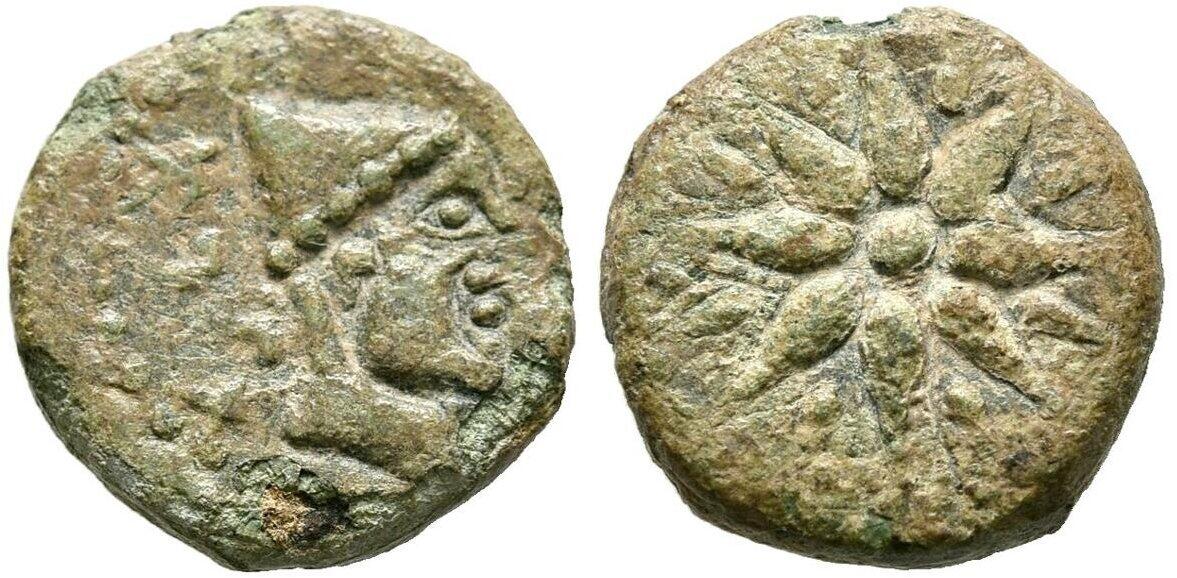S 1667 - Malaca, bronze, 1-3g (200-150 BCE)
From SILVER
200 BCE - 150 BCE Bronze
Description
| ObverseInscription or printing placed on the obverse.: | (Punic).Head of Vulcan to right, behind Punic legend type A |
| ReverseInscription or printing placed on the reverse.: | Star with eight rays |
Mint and issuing power
| MintIdentifies the place of manufacture or issue of a numismatic object.: | Malaca | Ancient regionAncient region.: | Hispania Ulterior | Modern countryModern country: Spain | AuthorityIdentifies the issuing power. The authority can be "pretended" when the name or the portrait of X is on the coin but he/she was not the issuing power. It can also be "uncertain" when there is no mention of X on the coin but he/she was the issuing power according to the historical sources: |
Chronology
| FromIdentifies the initial date in a range assigned in a numismatic context. | 200 BCE | toIdentifies the final date in a range assigned in a numismatic context.. | 150 BCE | PeriodTime period of the numismatic object.: Hellenistic 323-30 BC |
Physical description
| MetalThe physical material (usually metal) from which an object is made.: | Bronze |
Median weightMedian of the weights of numismatic objects (in grams). in grams | 2.50 | DenominationTerm indicating the value of a numismatic object. Examples: tetradrachm, chalkous, denarius.: | StandardStandard.: |
Image

S 1667 - Malaca, bronze, units (225-200 BCE).jpg [1]
References
| Die study referencePublication of the study: | Campo - Mora-Serrano 19951Campo - Mora-Serrano 1995, p. 223-227, n° 1-19 (Pertiod I) | ||
| Coin series referenceReference to coin series study: | |||
Obverse dies distribution
| FrequencyFrequency of specimen in distribution. ᵖ | Number of obversesNumber of obverse dies. ᵖ (o) | % (o) | Number of coinsNumber of coins. (n) | % (n) | Die nameName(s) of the die(s). |
| 1 | 12 | 63.16 | 12 | 33.33 | 1, 2, 4, 5, 6, 8, 9, 11, 12, 13, 18, 19 |
| 2 | 2 | 10.53 | 4 | 11.11 | 3, 10 |
| 3 | 3 | 15.79 | 9 | 25 | 7, 15, 16 |
| 4 | 1 | 5.26 | 4 | 11.11 | 17 |
| 7 | 1 | 5.26 | 7 | 19.44 | 14 |
| Total | 19 of 19 | 100 | 36 of 36 | 99.99 |
Reverse dies distribution
no distribution is available
Quantification
| Number of obversesNumber of obverse dies. ᵖ (o) | 19 | Number of singletons (o1)The number of singleton coins. ᵖ | 12 |
| Number of reverse diesNumber of reverse dies. (r) | Number of coinsNumber of coins. (n) | 36 | |
| Coins per obverse dieNumber of coins per obverse die. (n/o) | 1.89 | Coins per reverse dieNumber of coins per reverse die. (n/r) | |
| Reverse per obverse ratioRatio of obverse dies divided by reverse dies. (r/o) | Percentage of singletons (o1)number of coins (n) divided by the number of singletons (o1) ᵖ | 63.16 % | |
| Original number of dies (O) (Carter 1983 formula)The estimation of the number of coins according to Carter 1983 ᵖ | 32.63 | Coins struck if 20,000 as average productivity per dieCoins made if the average productivity for obverses (according to Carter) is 20,000. ᵖ | 652,600 |
| Original number of dies (O) (Esty 2011 formula)The estimation of the number of coins according to the singleton formula in Esty 2011 ᵖ (O) | 40.24 | Survival rate if 20,000 as average productivity per dieSurvival rate if average productivity is 20,000. ᵖ | 0.00006 |
| Coverage (o = % of O) (Esty 1984 formula)Esty 1984 - coverage (% of O) ᵖ (o = % of O) | 66.67% | Die productivity if survival rate 1/2,000Average productivity if survival rate is 1/2,000. ᵖ | 2,206.56 |
| Weight of silver (in kg) if 20,000 coins per die (O = Carter formula)Carter 1983 * Median weight * 20000 (*10 if gold or electrum) ᵖ | n.a. | Die productivity if survival rate 1/5,000Average productivity if survival rate is 1/5,000. ᵖ | 5,516.4 |
Remarks
References
- ^ Campo, Marta - Mora-Serrano, Bartolomé (1995), Las monedas de Malaca, Madrid, Museo Casa de la Moneda, 341 p.